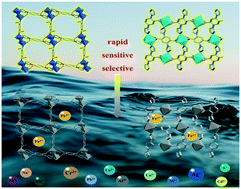Two exceptionally stable luminescent MOFs for the selective and sensitive detection of Fe3+ ions in aqueous solution†
Abstract
Both an excess and shortage of iron(III), away from normal permissible limits, can induce serious disorders, therefore its detection is significant, but still remains a challenge. Luminescent metal–organic frameworks (LMOFs) are a class of attractive materials for the detection of Fe3+ ions. However, improvement in their hydrolytic stability, speed, sensitivity, and selectivity of function is the key to the advanced application of LMOFs in an aqueous environment. Herein, two hydrostable LMOFs, Zn-DTA and Cd-DTA, based on the π-conjugated aromatic ligand 2,5-di(1H-imidazol-1-yl)terephthalic acid (H2DTA), were selected as highly efficient sensors for the rapid, sensitive and selective detection of Fe3+ in aqueous solutions. On the basis of the rigid structure and multiple coordination sites of the H2DTA ligand, Zn-DTA and Cd-DTA possess brilliant stability and excellent fluorescence emission. Both of them exhibit high selectivity (Ksv = 8400 and 6420 M−1) and high sensitivity (0.82 and 1.07 μM) for the rapid detection (less than 30 s) of small quantities of Fe3+ (0.2 mg mL−1) in water. It is worth noting that the compounds not only remain stable in the water for a long time but also maintain structural integrity at high temperatures. To the best of our knowledge, Zn-DTA and Cd-DTA, as two exceptionally stable MOF chemosensors used for the selective detection of Fe3+, show very rare behavior compared to the reported Zn/Cd-MOFs. The quenching mechanism for such a high selectivity can be mainly explained by the competition between the absorption of Fe3+ and the excitation of the compounds. Moreover, the introduced carboxyl O atoms of Zn-DTA additionally donate their lone-pair electrons to the Fe3+ ions, leading to enhanced detection ability. Our work reveals the enormous potential of LMOFs as an appealing platform upon which to construct sensing materials.



 Please wait while we load your content...
Please wait while we load your content...